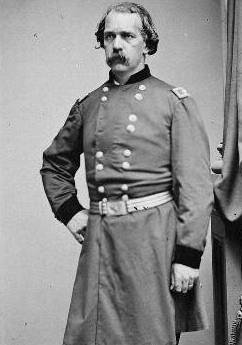
John Henry Hobart Ward was an American soldier who fought in the Mexican–American War and in the American Civil War. Ward joined the army in 1842 and fought in multiple battles in the Mexican–American war, including the Battle of Monterrey, where he was wounded. After leaving the army, he served successively as the assistant commissary general and commissary general for the state of New York. With the outbreak of the American Civil War in 1861, Ward rejoined the army, and became the colonel of the 38th New York Infantry Regiment. Ward and his regiment were engaged in the First Battle of Bull Run and in several battles in the Peninsula campaign. He was promoted to command a brigade after the Battle of Chantilly in September 1862.
The Philadelphia Brigade was a Union Army brigade that served in the American Civil War. It was raised primarily in the city of Philadelphia, Pennsylvania, with the exception of the 106th regiment which contained men from Lycoming and Bradford counties.
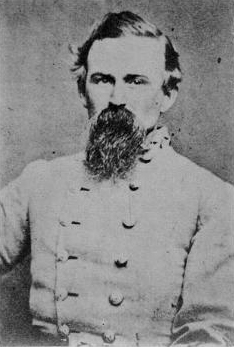
George Pierce Doles was a Georgia businessman and Confederate general during the American Civil War. His men played a key role on the first day of the Battle of Gettysburg in driving back the Union XI Corps.

Brigadier-General Abner Monroe Perrin was an American lawyer who served as a senior officer of the Confederate States Army in the American Civil War until killed in action at the Battle of Spotsylvania Court House.
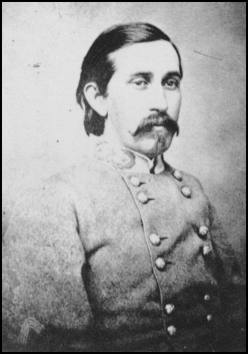
Robert Daniel Johnston was a brigadier general for the Confederate States of America during the American Civil War.
The 10th Louisiana Infantry Regiment was a Louisiana infantry unit of the Confederate States of America that operated with the Army of Northern Virginia of the American Civil War. It was known as "Lee's Foreign Legion" due to the large numbers of foreign-born troops.
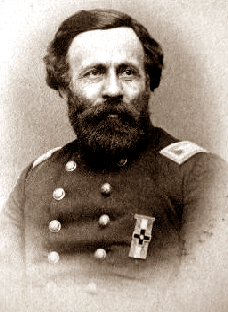
Hiram Burnham was an officer in the Union Army who commanded a regiment and then a brigade in the Eastern Theater of the American Civil War. He was killed in battle while assaulting Confederate positions near Richmond, Virginia, during the Battle of Chaffin's Farm.
Jesse Milton Williams commanded a Louisiana regiment in the American Civil War. He briefly held brigade command at the Battle of Gettysburg. Prior to the Civil War, Williams attended the University of Alabama and lived in Mansfield, Louisiana.

Brigadier-General Nathaniel Harrison Harris was a senior officer of the Confederate States Army who commanded infantry in the Eastern theater of the American Civil War.

The 6th Louisiana Infantry Regiment served in the Confederate States Army during the American Civil War. It was part of the Louisiana Tigers. Formed in June 1861 at Camp Moore, it fought in Jackson's Valley campaign, the Battle of Gaines Mill, the Second Battle of Bull Run and its related actions, and the Battle of Antietam in 1862. The next year, it fought at the Second Battle of Fredericksburg, the Battle of Salem Church, the Second Battle of Winchester, and the Battle of Gettysburg before being overrun at the Second Battle of Rappahannock Station. It spent 1864 fighting in Grant's Overland campaign and with Jubal Early in the Valley campaigns of 1864. The regiment fought in the Battle of Hatcher's Run and the Battle of Fort Stedman in early 1865 before surrendering after the Battle of Appomattox Court House in April. It began its service with 916 men and ended with 52.
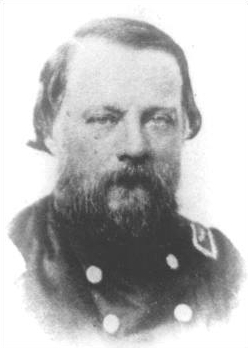
The 1st Louisiana Infantry Regiment was a unit of volunteers recruited in Louisiana that fought in the Confederate States Army during the American Civil War. Formed in April 1861, the regiment was sent to fight in the Eastern Theater of the American Civil War. Joining a brigade of Louisiana regiments, it fought at Malvern Hill, Second Bull Run, Antietam, and Fredericksburg in 1862, at Chancellorsville, Second Winchester, Gettysburg, and Mine Run in 1863, and at the Wilderness, Spotsylvania, Monocacy, Third Winchester, Fisher's Hill, Cedar Creek, and Petersburg in 1864, and at Appomattox in 1865. At Appomattox, the regiment was only a shadow of its former self.
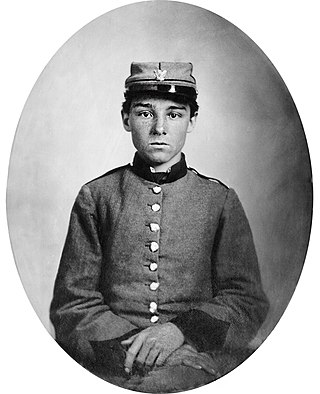
The 2nd Louisiana Infantry Regiment was a unit of volunteers recruited in Louisiana that fought in the Confederate States Army during the American Civil War. Formed in May 1861, the regiment was sent to fight in the Eastern Theater of the American Civil War. Its first action took place during the Siege of Yorktown. The regiment suffered very heavy losses at Malvern Hill. After joining an all-Louisiana brigade, it fought at Cedar Mountain, Second Bull Run, Antietam, and Fredericksburg in 1862, at Chancellorsville, Second Winchester, Gettysburg, and Mine Run in 1863, and at the Wilderness, Spotsylvania, Cold Harbor, Monocacy, Third Winchester, Fisher's Hill, Cedar Creek, and Petersburg in 1864, and at Appomattox in 1865. The regiment lost over 100 men at both Second Bull Run and Chancellorsville. A company-sized remnant surrendered at Appomattox.

The Louisiana Guard Battery was an artillery unit recruited from volunteers in Louisiana that fought in the Confederate States Army during the American Civil War. Formed from an infantry company sent to fight in the Eastern Theater of the American Civil War, it was converted to an artillery company in July 1861. The battery fought at Cedar Mountain, Second Bull Run, Antietam, and Fredericksburg in 1862, and at Chancellorsville, Second Winchester, and Gettysburg in 1863. Most of the soldiers and all of the battery's guns were captured at Rappahannock Station on 7 November 1863. The surviving gunners manned heavy artillery pieces in the defenses of Richmond, Virginia, and the battery's remnant surrendered at Appomattox.

The 8th Louisiana Infantry Regiment was a unit of volunteers recruited in Louisiana that fought in the Confederate States Army during the American Civil War. Formed in June 1861, the regiment was sent to fight in the Eastern Theater of the American Civil War. Joining a brigade of Louisiana regiments, it fought in Jackson's Valley campaign and at Gaines' Mill, Malvern Hill, Second Bull Run, Antietam, and Fredericksburg in 1862. The regiment served at Chancellorsville, Second Winchester, Gettysburg in 1863. At Rappahannock Station in November 1863, most of the regiment was captured. The unit fought at the Wilderness, Spotsylvania, Cold Harbor, and the Valley campaigns of 1864. It served at Petersburg starting in December 1864 and surrendered at Appomattox in April 1865.

The Donaldsonville Louisiana Artillery was a Louisiana artillery unit that fought in the Confederate States Army during the American Civil War. Formed from an old militia company, it arrived in the Eastern Theater of the American Civil War in September 1861 with three obsolete guns and was equipped with three additional rifled guns. The battery fought at Yorktown, Williamsburg, Seven Pines, Gaines' Mill, Glendale, Second Bull Run, Antietam, Shepherdstown and Fredericksburg in 1862. The following year the unit served at Gettysburg and in the Bristoe and Mine Run campaigns. The battery fought in the Overland campaign and at the Siege of Petersburg in 1864. It surrendered at Appomattox in April 1865.

The Madison Louisiana Light Artillery was a Louisiana artillery unit that fought in the Confederate States Army during the American Civil War. Formed as an infantry company, it arrived in the Eastern Theater in May 1861 and was converted to an artillery battery in August. The unit was armed with six guns in 1861, but by September 1862, it had only four guns. It served at Garnett's and Golding's Farm, Savage's Station, Second Bull Run, Antietam, and Fredericksburg in 1862. The battery fought at Chancellorsville and Gettysburg and in the Knoxville campaign in 1863. The Madison Light Artillery served in the Overland campaign and at the Siege of Petersburg in 1864. The unit surrendered at Appomattox in April 1865.

The 7th Louisiana Infantry Regiment was a unit of volunteers recruited in Louisiana that fought in the Confederate States Army during the American Civil War. Formed in June 1861, the regiment was sent to fight in the Eastern Theater of the American Civil War. After fighting at First Bull Run, the unit joined the 1st Louisiana Brigade. The regiment served in Jackson's Valley campaign and at Gaines' Mill, Malvern Hill, Cedar Mountain, Second Bull Run, Harpers Ferry, Antietam, and Fredericksburg in 1862. The regiment fought at Chancellorsville, Second Winchester, and Gettysburg in 1863. At Rappahannock Station in November 1863, almost the entire regiment was captured. The remnant of the unit fought at the Wilderness, Spotsylvania, Cold Harbor, and the Valley campaigns of 1864. It served at Petersburg starting in December 1864 and surrendered at Appomattox in April 1865.
The 5th Louisiana Infantry Regiment was a unit of volunteers recruited in Louisiana that fought in the Confederate States Army during the American Civil War. Formed in June 1861, the regiment was sent to fight in the Eastern Theater of the American Civil War. The regiment served at Yorktown, White Oak Swamp, Cedar Mountain, Second Bull Run, Harpers Ferry, Antietam, and Fredericksburg in 1862. The regiment fought at Chancellorsville, Second Winchester, and Gettysburg in 1863. At Rappahannock Station in November 1863, virtually the whole regiment was captured. The unit's remnant fought at the Wilderness, Spotsylvania, Cold Harbor, and the Valley campaigns of 1864. It served at Petersburg starting in December 1864 and a mere handful surrendered at Appomattox in April 1865.

The 15th Louisiana Infantry Regiment was a unit of volunteers recruited in Louisiana that fought in the Confederate States Army during the American Civil War. Formed in June 1861 as the 2nd Regiment, Polish Brigade, the unit was sent to fight in the Eastern Theater of the American Civil War. As the 3rd Louisiana Infantry Battalion, the unit served at Beaver Dam Creek and Glendale. After two companies from the 7th Louisiana Infantry Battalion were added in July 1862, the unit reorganized as the 15th Louisiana Infantry Regiment. It joined the 2nd Louisiana Brigade and fought at Cedar Mountain, Second Bull Run, Antietam, and Fredericksburg in 1862. It served at Chancellorsville, Second Winchester, Gettysburg, and Mine Run in 1863. The regiment fought at the Wilderness, Spotsylvania, Cold Harbor, Monocacy, Third Winchester, Fisher's Hill, Cedar Creek, and Petersburg in 1864. A handful of survivors surrendered at Appomattox in 1865.

The 30th Louisiana Infantry Regiment was a unit of volunteers recruited in Louisiana that fought in the Confederate States Army during the American Civil War. On 17 December 1861, the Sumter Regiment was accepted into state service at New Orleans. On 1 March 1862, the militia regiment transferred to Confederate service for a 90-day enlistment. At the Capture of New Orleans on 25 April, three and a half companies stayed in the city and were captured. The other companies went to Camp Moore where the regiment reorganized for Confederate service on 15 May 1862, by the addition of four more companies. Company K left on furlough and never returned. The regiment fought at Baton Rouge before being assigned to garrison Port Hudson. On 4 March 1863, two companies were suppressed and their men reassigned to other companies, officially reducing the regiment to a 7-company unit named the 30th Louisiana Infantry Battalion. However, contemporary records often continued to refer to the unit as a regiment. A detachment was captured at the Siege of Port Hudson, but the bulk of the battalion served at Jackson in 1863, and New Hope Church, Atlanta, Ezra Church, and Nashville in 1864. The survivors were consolidated with the remnants of the 4th and 13th Louisiana Infantry Regiments, and the 14th Louisiana Battalion in February 1864. The men fought at Spanish Fort in March and April 1865, and surrendered in May 1865.
















